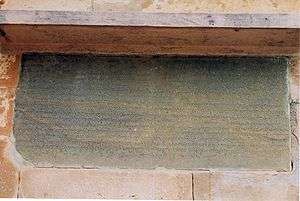Aihole inscriptions

Aihole in Karnataka state, India, is known as Cradle of Indian architecture. It was the first capital of Chalukyas where they built numerous temples dating back to the 6th century CE.
Introduction
Many inscriptions found at Aihole, but the inscription which found at Meguti Temple popularly known as Aihole inscription, which has the significance in the history of India, witnessed for the many historical events of Chalukyas. The inscription written in Sanskrit and it is in Kannada script. There is a mention about the defeat of Harshavardhana by Pulikeshi II.[1] And there is a mention about the victory of Chalukyas on Pallavas, also mentioned about the shifting of the capital from Aihole to Badami by Pulikeshi. There is mention about the poet Kalidasa.
Aihole Inscription of Pulakesin II
The inscription is found at Aihole in Karnataka state, India. The Aihole inscription was written by the Ravikirti, court poet of Chalukya King, Pulakeshi II who reigned from 610 to 642 CE. The poetic verses (Shilalekh) of Ravikirti, in praise of the king, can be read in the Meguti temple,[2] dated 634 CE. The inscription is in the Sanskrit language, which uses the old Kannada script.[3]
Aihole inscription of Pulakesin II mentioned as akrantatma-balonnatim Pallavanam patim, means that the Pallavas had attempted to prevent the rise of the Badami Chalukyas. The conflict of the two powers before the campaign of Pulakesin II against the Pallavas Inscription, which was prepared by Pulakeshi II (634 AD) and found in the Jain Temple at Aihole. Scholars have used this inscription, which is related to the Mahabharata War and Kaliyuga.[4] In the Aihole inscription referred that Mangalesha's (Paramabhagavat) victory over the Kalachuris and the conquest of Revatidvipa. According to the Aihole inscription of Pulakeshin II, a civil war between Mangalesha and Pulakeshin II, due to Mangalesa's attempt to secure the succession for his own son, which was the end of Mangalesha's reign.[5] The inscription of Amoghavarsha I found at Aihole, mentioned his new administration (navarajyam geyye).[6]

External links
References
- ↑ "Aihole's stories in stone". Retrieved 2013-05-02.
- ↑ Project South Asia (2000–2005). "Project South Asia". South Dakota State University - Be Great. Start Here. SDSU South Dakota State University. Retrieved 27 May 2012.
- ↑ Dr. Jyotsna Kamat (2 January 2012). "Inscriptions - Message with Long Life: Indian Inscriptions". Kamat's Potpourri. Kamat's Potpourri. Retrieved 27 May 2012.
- ↑ Dr. P.V.Vartak (2009–2011). "The Scientific Dating of the Mahabharat War". Library Of Hindu History. Dharma Universe. Retrieved 27 May 2012.
- ↑ Unknown. "HISTORY - EARLY CHALUKYAS". Welcome to the Gazetteers Department. Maharashtra State Gazetteers. Retrieved 27 May 2012.
- ↑ Unknown. "The Indian Analyst : South Indian Inscriptions : BOMBAY-KARNATAKA INSCRIPTIONS VOLUME I - Part I". WhatIsIndia.com. What Is India Publishers (P) Ltd. Retrieved 27 May 2012.